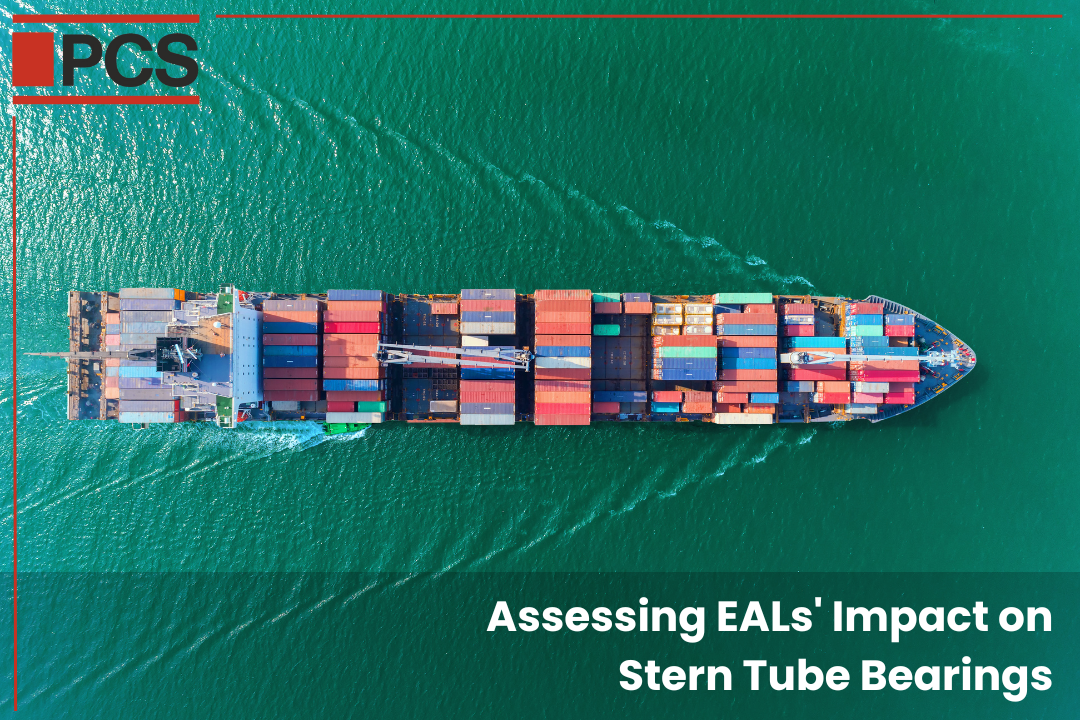Assessing EALs’ Impact on Stern Tube Bearings

The maritime industry has witnessed a notable increase in stern tube bearing failures coinciding with the introduction of Environmentally Acceptable Lubricants (EALs). Here we explore the key findings from recent investigations by DNV GL and Gard, shedding light on the implications of EAL usage on stern tube bearing integrity.
Since the implementation of the Vessel General Permit (VGP) requirements in 2013, there has been a significant rise in the use of EALs as stern tube lubricants for ships. This surge in EAL usage has been accompanied by a global increase in stern tube bearing failures. The adoption of EALs represents a proactive response to environmental regulations, aiming to reduce the ecological impact of maritime operations. However, alongside environmental benefits, there have been concerns about the performance of EALs in critical applications such as stern tube lubrication.
DNV GL Investigation [3]
In October 2019, DNV GL published a comprehensive study highlighting the impact of EALs on stern tube bearing failures. The study, conducted in collaboration with leading insurers and maritime stakeholders, aimed to address critical knowledge gaps regarding EAL performance in stern tube applications. By analysing data from vessel operations and conducting laboratory tests, DNV GL sought to provide insights into the operational challenges posed by EALs and propose recommendations for mitigating associated risks.
Key Findings
- Operating Conditions and Bearing Failures [3]: The study revealed that most stern tube bearing failures occurred early in the vessels’ lifetimes, particularly during sharp turns at higher speeds. These operational conditions imposed significant loads on the aft stern tube bearing, leading to localised stress concentrations and lubrication challenges. The findings underscored the importance of understanding the dynamic operating environment of stern tube bearings and its implications for lubricant performance.
- Viscosity Characteristics [3]: One of the key discoveries of the study was the differences in viscosity characteristics between EALs and traditional mineral oils. Under high-load conditions, such as sharp turns at high speeds, EALs exhibited lower viscosity under pressure compared to mineral oils of the same grade. This lower viscosity reduced the safety margin of the lubricant film, potentially compromising the effectiveness of hydrodynamic lubrication and increasing the risk of bearing failure. Additionally, EALs demonstrated lower viscosity at lower temperatures, posing challenges during cold starts and mooring trials.
Recommendations by DNV GL
Based on the study findings, DNV GL proposed targeted recommendations to address the challenges posed by EAL usage [1]:
- For Existing Vessels: When transitioning from mineral oils to EALs, selecting EALs with higher viscosity (one grade up) is recommended to mitigate lubrication challenges and maintain adequate safety margins.
- For New-Building Vessels: Optimising aft stern tube bearing designs, such as incorporating double-sloped bearings, can enhance shaft-bearing contact area to compensate for reduced safety margins with EALs. Additionally, DNV GL revised main class shaft alignment rules to account for the performance characteristics of EALs and ensure equivalent safety margins for stern tube bearings.
Gard’s Insights [2]
Gard’s independent research corroborated the concerns raised by DNV GL, indicating a significant increase in propeller shaft aft seal damage following the widespread adoption of synthetic EALs. This highlights the challenges posed by EALs’ inferior performance compared to traditional mineral oils, especially under high-load operations and lower temperature conditions. Gard’s findings underscored the importance of considering both environmental and operational factors when evaluating lubrication strategies for marine propulsion systems.
Conclusion
In summary, the investigations by DNV GL and Gard underscore the critical importance of evaluating Environmentally Acceptable Lubricants (EALs) in maritime applications, particularly stern tube bearings. While EALs offer environmental benefits, concerns about their impact on operational safety, as evidenced by increased stern tube bearing failures, must be carefully considered. Integrating insights from these investigations, along with the actionable recommendations provided by DNV GL, stakeholders can make informed decisions to optimise lubrication strategies and ensure the integrity of marine propulsion systems. These recommendations, recognised as useful and actionable findings, serve as valuable guidelines for navigating the challenges associated with EAL usage in the maritime industry.
References
[1] DNV GL. (2019, October). The Effect of Environmentally Acceptable Lubricants (EAL) on Stern Tube Bearings. [Online]. Available: https://www.dnv.com/news/environmentally-acceptable-lubricants-show-reduced-capabilities-under-certain-conditions-158982/
[2] Maritime Executive. (2023, November 28). New Evidence Shows Synthetic EALs Cause Increased Stern Tube Seal Failures. [Online]. Available: https://maritime-executive.com/corporate/new-evidence-shows-synthetic-eals-cause-increased-stern-tube-seal-failures
[3] DNV GL. (2019, October). Technical and Regulatory News No. 15/2019 – Technical Environmentally Acceptable Lubricants Show Reduced Capabilities Under Certain Conditions. [Online]. Available: https://www.lagersmit.com/blog/the-effect-of-environmentally-acceptable-lubricants-eal-on-stern-tube-bearings
